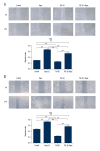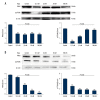Mammalian Target of Rapamycin (mTOR) Regulates Transforming Growth Factor-β1 (TGF-β1)-Induced Epithelial-Mesenchymal Transition via Decreased Pyruvate Kinase M2 (PKM2) Expression in Cervical Cancer Cells
- PMID: 28446743
- PMCID: PMC5417590
- DOI: 10.12659/msm.901542
Mammalian Target of Rapamycin (mTOR) Regulates Transforming Growth Factor-β1 (TGF-β1)-Induced Epithelial-Mesenchymal Transition via Decreased Pyruvate Kinase M2 (PKM2) Expression in Cervical Cancer Cells
Abstract
BACKGROUND Epithelial-mesenchymal transition (EMT) plays an important role in cancer tumorigenesis. Transforming growth factor β1 (TGF-β1) can induced EMT, which could increase tumor migration and invasion. Moreover, recent studies have been proven that mammalian target of rapamycin (mTOR) is a critical regulator of EMT. We investigated the mechanisms of mTOR in transforming growth factor β1 (TGF-β1)-induced EMT in cervical cancer cells. MATERIAL AND METHODS HeLa and SiHa cells were treated with 10 ng/ml TGF-β1 to induce EMT. Then, they were treated with or without rapamycin. CCK8 assay was performed to determine cell proliferation. Cell migration was detected by wound-healing assay; apoptosis was analyzed by flow cytometry; mTOR inhibitors inhibited mTOR pathway to assess the expression of E-cadherin, Vimentin STAT3, Snail2, p-p70s6k, and PKM2 expression. RESULTS TGF-β1 promoted proliferation and migration, and attenuated apoptosis in cervical carcinoma cells. Rapamycin abolished TGF-β1-induced EMT cell proliferation and migration and reversed TGF-β1-induced EMT. E-cadherin were suppressed, whereas Vimentin and PKM2 were increased in HeLa and SiHa cells after stimulation with TGF-β1. Moreover, mTOR was activated in the process of TGF-β1-induced EMT. Rapamycin inhibited the phosphorylation of p70s6k. Furthermore, inhibition of the mTOR pathway decreased PKM2 expression. CONCLUSIONS Inhibition of the mTOR pathway abolished TGF-β1-induced EMT and reduced mTOR/p70s6k signaling, which downregulated PKM2 expression. Our results provide novel mechanistic insight into the anti-tumor effects of inhibition of mTOR.
Conflict of interest statement
The authors declare no conflicts of interest.
Figures









Similar articles
-
Metformin Inhibits TGF-β1-Induced Epithelial-to-Mesenchymal Transition via PKM2 Relative-mTOR/p70s6k Signaling Pathway in Cervical Carcinoma Cells.Int J Mol Sci. 2016 Nov 30;17(12):2000. doi: 10.3390/ijms17122000. Int J Mol Sci. 2016. PMID: 27916907 Free PMC article.
-
Aspirin-triggered resolvin D1 inhibits TGF-β1-induced EMT through the inhibition of the mTOR pathway by reducing the expression of PKM2 and is closely linked to oxidative stress.Int J Mol Med. 2016 Oct;38(4):1235-42. doi: 10.3892/ijmm.2016.2721. Epub 2016 Aug 29. Int J Mol Med. 2016. PMID: 27573422
-
Inhibition of mTOR ameliorates bleomycin-induced pulmonary fibrosis by regulating epithelial-mesenchymal transition.Biochem Biophys Res Commun. 2018 Jun 12;500(4):839-845. doi: 10.1016/j.bbrc.2018.04.148. Epub 2018 May 2. Biochem Biophys Res Commun. 2018. PMID: 29704504
-
Emergence of the phosphoinositide 3-kinase-Akt-mammalian target of rapamycin axis in transforming growth factor-β-induced epithelial-mesenchymal transition.Cells Tissues Organs. 2011;193(1-2):8-22. doi: 10.1159/000320172. Epub 2010 Nov 2. Cells Tissues Organs. 2011. PMID: 21041997 Free PMC article. Review.
-
Role of AKT and mTOR signaling pathways in the induction of epithelial-mesenchymal transition (EMT) process.Biochimie. 2019 Oct;165:229-234. doi: 10.1016/j.biochi.2019.08.003. Epub 2019 Aug 8. Biochimie. 2019. PMID: 31401189 Review.
Cited by
-
Wubeizi Ointment Suppresses Keloid Formation through Modulation of the mTOR Pathway.Biomed Res Int. 2020 Sep 30;2020:3608372. doi: 10.1155/2020/3608372. eCollection 2020. Biomed Res Int. 2020. PMID: 33062677 Free PMC article.
-
Infection by High-Risk Human Papillomaviruses, Epithelial-to-Mesenchymal Transition and Squamous Pre-Malignant or Malignant Lesions of the Uterine Cervix: A Series of Chained Events?Int J Mol Sci. 2021 Dec 17;22(24):13543. doi: 10.3390/ijms222413543. Int J Mol Sci. 2021. PMID: 34948338 Free PMC article. Review.
-
Tumor pyruvate kinase M2 modulators: a comprehensive account of activators and inhibitors as anticancer agents.RSC Med Chem. 2021 May 17;12(7):1121-1141. doi: 10.1039/d1md00045d. eCollection 2021 Jul 21. RSC Med Chem. 2021. PMID: 34355179 Free PMC article. Review.
-
The Communication Between the PI3K/AKT/mTOR Pathway and Y-box Binding Protein-1 in Gynecological Cancer.Cancers (Basel). 2020 Jan 14;12(1):205. doi: 10.3390/cancers12010205. Cancers (Basel). 2020. PMID: 31947591 Free PMC article. Review.
-
The Epithelial-to-Mesenchymal Transition as a Possible Therapeutic Target in Fibrotic Disorders.Front Cell Dev Biol. 2020 Dec 21;8:607483. doi: 10.3389/fcell.2020.607483. eCollection 2020. Front Cell Dev Biol. 2020. PMID: 33409282 Free PMC article. Review.
References
-
- Maeda M, Johnson KR, Wheelock MJ. Cadherin switching: Essential for behavioral but not morphological changes during an epithelium-to-mesenchyme transition. J Cell Sci. 2005;118(5):873–87. - PubMed
-
- Voulgari A, Pintzas A. Epithelial-mesenchymal transition in cancer metastasis: mechanisms, markers and strategies to overcome drug resistance in the clinic. Biochim Biophys Acta. 2009;1796(2):75–90. - PubMed
MeSH terms
Substances
LinkOut - more resources
Full Text Sources
Medical
Research Materials
Miscellaneous

